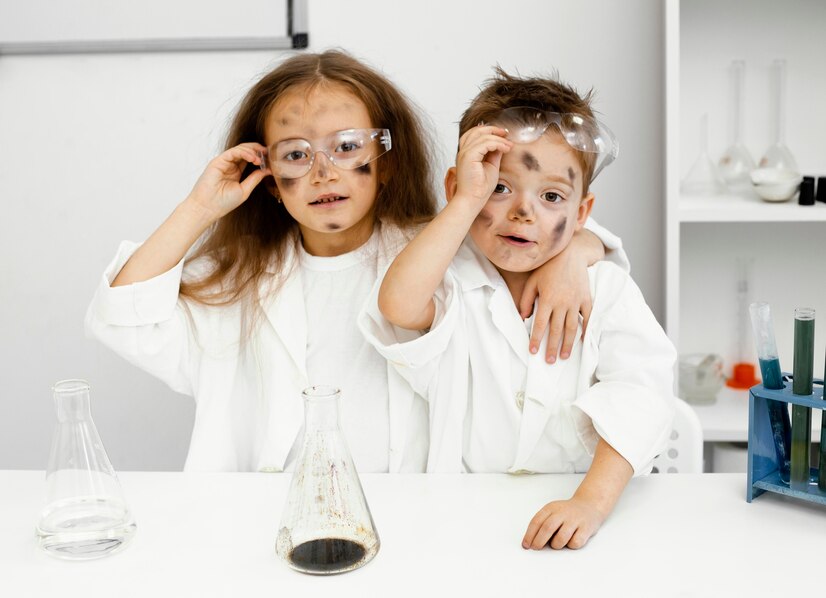The day my son, Oliver, asked me why his toy boat floated in the bathtub, I realized I had a budding scientist in my hands. That simple question led us down a fascinating path of discovery, turning our kitchen into a makeshift laboratory and our backyard into a field research station. Through trial, error, and more than a few messes, we’ve explored the wonders of science in ways that captivate his young mind and fuel his curiosity.
As a parent, I’ve learned that toddlers are natural scientists – always questioning, observing, and experimenting with the world around them. Our journey into simple science experiments has not only been incredibly fun but has also nurtured Oliver’s critical thinking skills and love for learning. So, let me share some of our favorite experiments that have turned everyday moments into exciting discoveries.
1. Sink or Float: This classic experiment never gets old. We gather various household items and predict whether they’ll sink or float in a tub of water. Oliver’s face lights up every time an item defies his expectations. It’s a great introduction to concepts like density and buoyancy.
2. Color Mixing Magic: Using food coloring and clear cups of water, we explore how primary colors combine to create new ones. Oliver loves playing “color wizard,” mixing drops to create his own rainbow. It’s wonderful for understanding color theory and developing fine motor skills.
3. Dancing Raisins: Drop some raisins in a glass of clear soda and watch them dance! The raisins sink and rise repeatedly, much to Oliver’s delight. It’s a fun way to introduce the concept of carbonation and density.
4. Tornado in a Bottle: We create a mini tornado using two plastic bottles, water, and a bit of dish soap. Oliver is fascinated by the swirling vortex and loves to make predictions about how fast it will form based on how hard he shakes it. It’s great for discussing weather phenomena.
5. Magnetic Treasure Hunt: We use a magnet to explore which household items are magnetic. Oliver enjoys being a “magnetic detective,” testing various objects. It’s an excellent way to introduce the concept of magnetism and material properties.
6. Exploding Sandwich Bag: This one’s always a hit! We combine baking soda and vinegar in a ziplock bag and watch it inflate and pop. Oliver loves the anticipation and the satisfying “pop.” It’s a safe way to demonstrate chemical reactions.
7. Walking Water: Using paper towels, cups, and food coloring, we create a “rainbow bridge” where colored water travels between cups. Oliver is amazed to see the colors mix as they travel. It’s fantastic for understanding capillary action and color mixing.
8. Homemade Lava Lamp: We create a simple lava lamp effect using water, oil, food coloring, and an effervescent tablet. Oliver is mesmerized by the bubbling “lava.” It’s great for discussing density and chemical reactions.
9. Seed Growing Experiment: We plant seeds in different conditions (with/without light, water, soil) and observe their growth. Oliver loves checking on “his” plants daily and recording their progress. It’s wonderful for understanding plant needs and the scientific process.
10. Ice Excavation: We freeze small toys in a block of ice and let Oliver figure out how to “rescue” them. He’s tried everything from warm water to salt, learning about melting and freezing in the process.

One of the most valuable lessons I’ve learned is to let Oliver lead the way. His questions and observations often spark our most interesting experiments. I’ve also realized the importance of embracing the mess. Yes, sometimes our experiments don’t go as planned, but those “failures” often lead to the most learning.
Safety, of course, is paramount. We always discuss lab safety rules before starting, and I supervise closely. But within those boundaries, I try to give Oliver as much hands-on experience as possible. The joy on his face when he makes a discovery on his own is priceless.
I’ve found that the key to keeping Oliver engaged is to connect our experiments to his everyday life. When he notices condensation on a cold glass, we talk about the water cycle. When he plays with his toy cars, we discuss friction and momentum.
These simple science experiments have become more than just activities to pass the time. They’ve fostered Oliver’s natural curiosity, taught him to ask questions and seek answers, and shown him the joy of discovery. They’ve also created countless moments of bonding and shared wonder between us.
So, I encourage you to embrace your toddler’s inner scientist. Turn your kitchen into a lab, your backyard into a research station. Ask questions, make predictions, and explore together. You don’t need fancy equipment or a science degree – just curiosity and a willingness to learn alongside your little one. In these simple experiments, you’ll find not just scientific principles, but a world of wonder, learning, and shared discovery. Happy experimenting!


